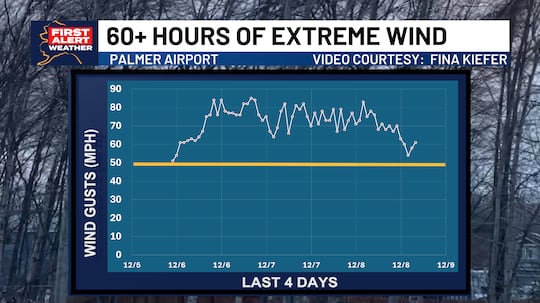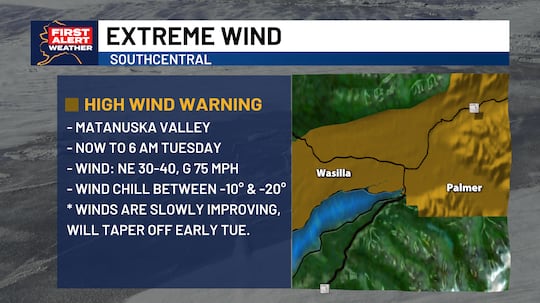Alaska
Family mourns the loss of two loved ones to drowning this summer

FAIRBANKS, Alaska (KTUU) – The Fairbanks community is mourning its second death seen this summer, linked to drowning in the Chena River, according to Fairbanks Police Department. The most recent death, hapened on July 19th, after FPD reported witnesses saw a man, later identified as 42-year-old, Elia Ansaknok, jumping into the river.
“We would like to urge all residents to use caution and safe practices, such as using lifejackets, when recreating on or swimming in the Chena River,” FPD shared on its Facebook page.
Ansaknok’s body was later discovered on Friday, after a week of search efforts. His niece, Lauren Ansaknok, sharing with Alaska’s News Source on Saturday, that her uncle was the nicest and funniest person she had ever met.
“We didn’t expect this loss, it was really sudden,” said Lauren. “The unknown and the uncertainty, if we were ever going to find him and when we were going to find him, that took a toll.”
During the past week, Lauren said her family has received an outpouring of love and support from the Fairbanks community including strangers, she said, donating their time and boats in efforts to find her uncle. Every day, Lauren said, there was a search party of about 30 people looking for Ansaknok.
“They’ve truly just been there for our family and it’s been something I’ve never experienced before,” said Lauren.
Especially during a time when her family is also grieving the loss of her uncle, Andrew, who she said died also from drowning a month ago in the Yukon River.
“So many people had come by just to support and bringing food and donations and as soon as they found out who it was and knowing that we had that loss previously, a month ago they were even more so present,” said Lauren.
Alaska is one of the leading states in the nation, when it comes to fatalities linked to drowning. Those rates particularly higher in males and people living in rural areas, according to a report State of Alaska Epidemiology. “I don’t ever want another family to go through what we’re going through,” said Lauren.
That’s exactly what swim coach and co-founder of the Aquatic Foundation of Alaska, Grant Gamblin, is aiming to make happen.
“Our 10 year goal is to have the drowning rates [lower] in Alaska,” said Gamblin.
AFA is aiming towards improving water safety and education throughout the state, especially focusing on rural parts of the state.
“Learning at a young age is proven to decrease so many so many unfortunate fatalities that have come through,” said Gamblin.
Gamblin said he also encourages that adults learn how to swim as well. A critical key skill, he said, that he can help them survive.
Lauren also wants Alaskans to remember how powerful bodies of water can be and how proper water safety precautions need to be taken.
“We want everyone to accept the power that is the Chena River and any other body of water,” she said. “People need their life preservers. Please don’t jump off a bridge to go swimming on a hot day. I know that’s a local activity on some of the bridges here. It’s just so unsafe.”
Between 2016 and 2021, Alaska had 342 fatal drownings. Thirty-three percent of victims were found to be using drugs or alcohol prior and another 20% had fallen off of a vessel.
Copyright 2024 KTUU. All rights reserved.

Alaska
Alaska Airlines launches new nonstop Seattle-to-London flight starting in 2026

Alaska Airlines announced its newest nonstop flight out of Seattle: a straight shot to London.
Starting in May 2026, the nonstop flight will travel from the Seattle-Tacoma International Airport (SEA) to Heathrow Airport, the largest international airport in the United Kingdom. The airport resides in Hounslow, located an hour outside of London.
The daily service will operate on Alaska Airlines’ 787 Dreamliner.
London is Alaska Airlines’ fifth intercontinental destination, alongside Rome, Reykjavik, Tokyo, and Seoul. According to the airline, the new route strengthens business ties, with London being the largest corporate market from Seattle.
“By 2030, we plan to serve at least 12 intercontinental destinations from Seattle, with additional routes to be announced in the years to come,” Alaska Airlines stated. “We currently have four Boeing 787-9s in our fleet, with a fifth aircraft recently delivered.”
Guests traveling from the U.S. can now purchase airfares to London for as low as $699 round-trip at alaskaair.com.
Alaska Airlines hit hard by federal shutdown
According to aviation analysts, the federal shutdown cost Alaska Airlines millions of dollars. The airline’s fourth-quarter income is expected to fall by $32 million.
The company told investors it lost 15 cents per share. Flight cancellations at SEA and other airports lasted 43 days.
According to The Puget Sound Business Journal, Delta reports a $200 million hit. United, JetBlue, and Southwest could see losses, too.
Follow Frank Sumrall on X. Send news tips here.
Alaska
Warnings continue for wind, snow, and extreme cold across Alaska

ANCHORAGE, AK (Alaska’s News Source) – Extreme wind has been non-stop for more than 60 hours in Wasilla in Palmer, where peak wind gusts have reached over 80 mph three days in a row.
Wind gusts at the Palmer Airport climbed over 50 mph Friday evening and didn’t drop below until late Monday evening.
The High Wind Warning for the Matanuska Valley will continue through 6 a.m. on Tuesday. Calmer conditions are likely on Tuesday afternoon as the winds relax across the area.
Send us your weather photos and videos here!
The rest of Southcentral remains clear and dry, with temperatures likely dropping to the lowest levels of the season starting Tuesday morning. This pattern will continue through the end of the week.
Download the free Alaska’s News Source Weather App for the latest forecast in your area.
In Southeast, Winter Storm Warnings are still in effect near Ketchikan for up to 8″ of additional snow through Tuesday. Winter Weather Advisories are also in effect near Hyder for an additional 9-12″ of snow on Tuesday.
The snow has ended across the northern areas of Southeast, but extreme cold is setting in. Wind Chill values will reach as low as -50° near Skagway, to -25° near Haines, and to -15° near Juneau.
The Copper River Basin will also experience extreme wind chill values to -50° through Tuesday afternoon.
In the Interior, temperatures dropped to -30° for the first time Monday morning, and we’ll see several nights at that cold level this week.
24/7 Alaska Weather: Get access to live radar, satellite, weather cameras, current conditions, and the latest weather forecast here. Also available through the Alaska’s News Source streaming app available on Apple TV, Roku, and Amazon Fire TV.
Copyright 2025 Alaska’s News Source. All rights reserved.
Alaska
Oregon State women pull away late to avoid upset against Alaska Anchorage

That was close. At least for a while.
Oregon State women’s basketball avoided an upset loss to Division II Alaska Anchorage on Sunday at Gill Coliseum, going on a 15-3 run to end the game and beat the visiting Seawolves, 69-53.
The Beavers (6-4) started slow but took control in the second half, surviving a barrage of three-pointers (11 of 37) from Alaska Anchorage (7-2) to pull out a win.
OSU was led by Tiara Bolden with 23 points, six rebounds and five assists. Katelyn Field poured in 11 as well for the Beavers on 3 of 6 three-point shooting.
10 different players scored as OSU coach Scott Rueck relied on his bench to get the team out of a funk.
The Beavers got off to a sluggish start. Alaska Anchorage came out firing, and took a 10-8 lead at the midpoint in the first quarter on a three by Kimberly Carrada.
After one, with the Seawolves shooting 56%, the Beavers trailed 24-18.
In the second quarter, Rueck emptied his bench and put typical reserves in the game, seemingly to send a message after a lackluster effort by his starters.
Alaska Anchorage extended its lead to 34-27 at one point, but OSU rattled off a 7-0 run to end the half and tie things up. The Beavers had 10 turnovers at half, with the Seawolves hitting six of an eye-popping 20 three-point attempts.
Rueck kept reserves in the game to start the second half, but when he re-inserted his starters, the Beavers opened up a 44-36 lead thanks in large part to Bolden’s scoring.
Jenna Villa hit a three-pointer at the buzzer to end the third, her first basket of the game after a cold start, which gave OSU a 52-42 lead through three.
Alaska Anchorage kept chucking from downtown as the fourth quarter began, and a pair of makes cut the OSU lead down to 54-48.
Despite going cold from the field, the Beavers tightened up their defense to keep it a six-point lead for an extended period. It got as close as four.
But Field nailed a three to get it to 59-50 with under four minutes remaining, and Bolden hit a pair of jumpers to extend the run to 10-0 and lead to 64-50 with 1:35 to go. The Beavers didn’t look back.
Next game: Oregon State (6-4) vs. Arizona State (10-0)
- When: Sunday, Dec. 14
- Time: 1:00 pm PT
- Where: Gill Coliseum, Corvallis
- Stream: ESPN+
-

 Alaska3 days ago
Alaska3 days agoHowling Mat-Su winds leave thousands without power
-

 Politics7 days ago
Politics7 days agoTrump rips Somali community as federal agents reportedly eye Minnesota enforcement sweep
-
Ohio5 days ago
Who do the Ohio State Buckeyes hire as the next offensive coordinator?
-

 News1 week ago
News1 week agoTrump threatens strikes on any country he claims makes drugs for US
-

 World7 days ago
World7 days agoHonduras election council member accuses colleague of ‘intimidation’
-

 Texas3 days ago
Texas3 days agoTexas Tech football vs BYU live updates, start time, TV channel for Big 12 title
-

 Miami, FL3 days ago
Miami, FL3 days agoUrban Meyer, Brady Quinn get in heated exchange during Alabama, Notre Dame, Miami CFP discussion
-

 Iowa2 days ago
Iowa2 days agoMatt Campbell reportedly bringing longtime Iowa State staffer to Penn State as 1st hire
























